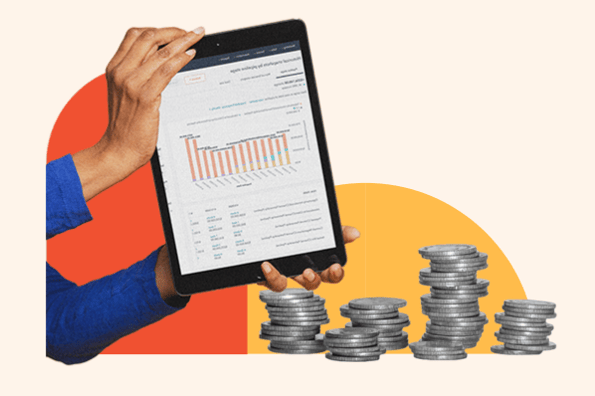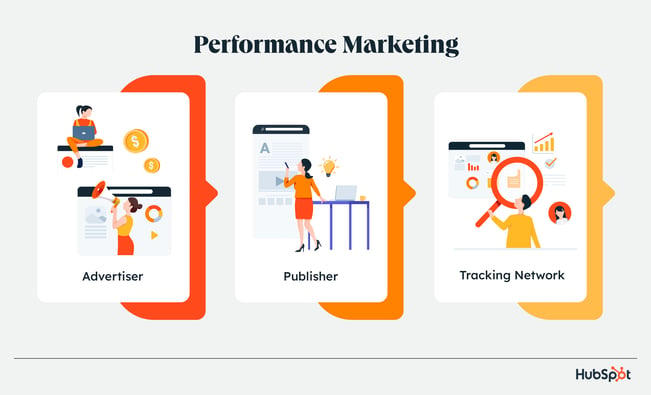How Performance Marketing Works [+ 6 Tools You Can Use]
Many companies have employee referral programs where referring someone who gets hired comes with a reward (typically a cash bonus).
![How Performance Marketing Works [+ 6 Tools You Can Use]](https://blog.hubspot.com/hubfs/performance%20marketing%20.png#keepProtocol)
Many companies have employee referral programs where referring someone who gets hired comes with a reward (typically a cash bonus). This is the same principle of performance marketing: marketers set a performance goal (like driving conversions) and reward the partners/people who help them get those conversions. Let’s dive deeper into how performance marketing works, how to create a performance marketing strategy, and the tools you can use to implement one. Table of Contents Performance marketing is a digital marketing strategy driven by results, where advertisers (like a brand or business) only pay once a goal is met, which can be anything from making a purchase to filling out a form on a landing page. With a traditional ad campaign approach, there's no guarantee you will get a return on your investment, and you can only monitor performance and make adjustments after it launches. Even seasoned media buyers can have unsuccessful campaigns if there's a misalignment between the campaign and the target audience. Since you’ll only pay when your goals are met, you accomplish three things: While somewhat related, affiliate marketing and performance marketing are different. Affiliate marketing is a subset of performance marketing based on paying a commission after each sale or target goal/conversion. Performance marketing has grown broader than just affiliate marketing, with the target goal of improving a company's performance as a whole. There are various performance marketing partners/channels to consider for your campaigns: Executing a performance marketing strategy relies on three key players: Some advertisers may use an outsourced program management (OPM) firm or agency that takes over running the program. With any digital marketing campaign, establishing your objectives is key. What do you want to accomplish? It may be general brand awareness, sales for your new product line, more leads, or something else. For example, if your goal is to attract new leads, you might have a performance marketing goal of drawing in 500 new leads. Once you define your goals, you can select the publisher/partner best suited to help you achieve them. Finding the right publisher/partner takes research, but it’s the most important step because it’s how you inspire people to convert. Today, influencers are some of the most popular partners because of the high level of trust they have with their audience. The influencer could be a YouTuber that adds an affiliate link in a video description or a blogger who adds a backlink to your landing page in their written content. Once you’ve found your partner or preferred channel, you also outline a payment structure. For example, with SEM, you’d likely design a program where you pay Google for impressions or clicks, and with an influencer, you’d decide how and how much you’d pay them whenever your goal is met. We’ll talk more about how to measure performance marketing below. The next step is to get your unique tracking links/URLs and codes ready. This is crucial because the only way to attribute an action to your partner/publisher correctly is with a unique code, URL, or UTM parameter. You may do this manually at first, but many people rely on automated tracking systems to ensure all conversion attributions are correct. Overall, the metric you use determines what actions trigger a commission payment and the ROI of your efforts. The more actions you drive, the more successful your campaign. Let’s say I’m an influencer partnered with Brandon Blackwood. I share a 10% discount code "MARTINA10" with my followers to use at checkout when purchasing an item from the brand. Whenever someone used my code to purchase, I would get a percentage of the sale. In this case, the tracked metric is unique sales from my code, which can be paid with a cost-per-acquisition model. Some standard measurement and pricing structures for performance marketing are: There are two main types of performance marketing software: those that focus on connecting advertisers with affiliate partners or publishers and those that monitor performance. Let's go through some top tools in each category. Price: Contact for pricing If you're a SaaS company looking to develop a robust partner program, consider PartnerStack. Price: Contact for pricing Partnerize is a simple and easy-to-use dashboard to manage your partners. Price: $750/mo (Core plan), contact for custom pricing Everflow helps you simplify partnership management to ensure you drive results. Key Features One of the biggest struggles of working with affiliates is creating and tracking links and codes at scale. Below we’ll go over some helpful tools. Price: $49/mo Starter), $129/mo (Plus), more advanced pricing for businesses with 15,000+ unique site visitors per month LeadDyno gives brands tools to grow a successful affiliate program that aligns rewards to your target actions. Price: 14-day free trial; $50/mo (Basic), $150/mo (Personal), $300/mo (Advanced) With AnyTrack, attribution reporting is easier. Price: Contact for pricing The Impact tool streamlines the partnership process from initial contact to payout. Wondering which industries use performance marketing the most? According to a 2022 study by the Performance Marketing Association, advertisers in the retail sector spent the most on performance marketing – accounting for 76% of total spending. The financial sector followed with a steep drop to 12%, then the travel industry with 5%. In terms of revenue, the sector with the highest revenue was retail at 84%, followed by travel at 10%. Industries like automotive, healthcare, and telecoms only accounted for 1% of the total performance marketing revenue. However, despite having the biggest spending and highest revenue percentages, the retail industry didn't offer the best ROAS. According to the report, the automotive industry offered the best return at $26, followed by travel at $21 and retail at $12. Any industry can have success with performance marketing. It's all about collaborating with the right partners and setting up a robust program to reach your marketing goals.
What is performance marketing?
Is affiliate marketing the same as performance marketing?
Types of Performance Marketing
How Performance Marketing Works

How To Create a Performance Marketing Strategy
1. Define your goals.
2. Identify your partners.
3. Generate and assign IDs.
How do you measure performance marketing?
Top Performance Marketing Software
Performance Marketing Partnership Tools
1. PartnerStack
Key Features
Choose from a network of active partners, or recruit your preferred partners.
Custom partner portal and automated onboarding to share relevant training resources.
Campaign tracking to understand performance and initiate payments.
2. Partnerize
Key Features
Build an invite-only network of partners, or get automated partner recommendations from its partner ecosystem.
Access to real-time campaign data to view partner performance.
Custom commission structure for each partner and automate the payment and reward process.
3. Everflow
Performance Marketing Tracking Tools
1. LeadDyno
Key Features:
Create links, codes, or assign specific URLs to each partner.
Unique affiliate dashboard to ensure you attribute conversions correctly.
Customize a payment structure based on your key metrics and seamlessly send payments.
2. AnyTrack.io
Key Features
Assign a tag to each partner that automatically tracks, attributes, and syncs your conversions.
Track every single engagement and sale to understand performance.
Integrate your custom affiliate network.
3. Impact
Key Features
Universal tracking tag helps you track the traffic your partners drive on all properties across any device.
Create payment contracts and automatically pay partners when they bring results on your key metrics.
Find partners that align with your needs or import your existing affiliate network.
Top Performance Marketing Verticals

 Konoly
Konoly ![Free Marketing Plan Template [Get Your Copy]](https://no-cache.hubspot.com/cta/default/53/aacfe6c7-71e6-4f49-979f-76099062afa0.png)














_2.jpg)


















